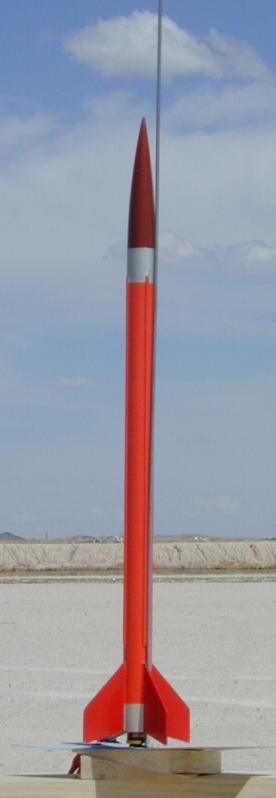| Manufacturer: | Aardvark Rockets |

(Contributed - by Frank Ross)
This formerly Blackhawk R&D rocket is now fully owned and produced by Aardvark Rockets
 Brief:
Brief:
Aerobee 350 scale mini-missile kit, 18mm mmt, streamer.
Construction:
The kit contained:
- BT-50 size kraft body tube
- solid balsa-foam nose cone w/screw eye
- basswood fin material
- mylar streamer
- 18mm mmt (tube, cardboard centering rings, engine block)
- Kevlar® shock cord
- elastic shock cord
- launch lug
- 3/32" balsa strips (for cosmetics)
After opening any kit I usually browse through the components both to check that all components arrived intact as well as to examine the quality of the kit. This was the first BRD mini-missiles kit that I've purchased so I looked over the contents pretty closely. I first read through the instructions, which are quite good, albeit lacking in diagrams/pictures, but well written and easy to follow.
I next noticed the nose cone which is quite unusual in comparison to a similar sized/priced Estes/Quest/Custom/etc. kit. The nose is solid, heavy (again in comparison), and of an unusual make. The RockSim file that I downloaded from the manufacturer's site has the material defined as "balsa-foam". That description sounds much lighter than the actual product which weighs in at 1.5 oz. with the screw eye in place. Although on the heavy side for this size of rocket it was shaped nicely, with no seam to sand. However, I did find that the diameter at the base of the cone is slightly smaller than that of the body tube so there is a slight, abrupt transition from cone to tube. In addition, the shoulder of the nose cone is similarly undersized so tape is required to keep the cone from falling out of the tube when inverted (or even turned on it's side, for that matter).
The remaining components and materials were all of good quality and in good shape. The instructions were easy to follow and the kit goes together quite nicely. It's a fairly simple design and construction is straight forward.
The fins for the kit must be cut from a sheet of basswood using an included template. I was quite impressed by the ample sheet of high-quality basswood that was included for this purpose. No skimping here. I would easily be able to cut twice the required four fins from the supplied sheet. I cut just four and put aside the extra for some yet-to-be-built scratch rocket (thanks!).
There is only one step that confused me when building the kit and that was in the location of the four balsa strips that run along the side of the tube, aligned with the four fins. According to my reference material (ROTW), if I'm reading it correctly that is, the runners should butt against each of the four fins. The instructions however clearly show the runners located starting an inch or so forward of each of the fins. I will continue to research but despite my concerns I followed the instructions to the letter.
Finishing:
One of the features I like about BRD's scale kits is the nice color scheme and
painting description that are included in the instructions. I found the kit
finished quite nicely following this guide.
Construction Rating: 3 out of 5
Flight:
Because of the sturdiness of this kit and design I decided I could start with a
motor on the higher end of the recommended list and started with an Aerotech
C4-5W 18mm reload. The motor casing fit fairly loosely in the mount so I added
a strip of tape to tighten the fit somewhat. The motor ignited slowly but
resulted in a picture-perfect flight to approximately 1000'. The streamer
ejected perfectly at apogee, however so did the motor casing.
Recovery:
The rocket descended quickly as I expected, but faster than I would like, led
by the solid nose cone and followed by the airframe and streamer (and lastly
the tumbling motor case). The rocket landed just yards from the launch pad.
Because of the high rate of descent there was a small dent made in the top of
the body tube, but no other significant damage. The motor casing was recovered
another 50' away (gotta like those dry lake bed launch sites!).
Flight Rating: 2 out of 5
Summary:
Pros: Good quality kit for those who like building as much as flying. Good
instructions and finishing descriptions. Very good quality and ample materials.
Cons: Nose cone sizing needs improvement. Nose cone either needs to be hollowed
by manufacturer or should include instruction to do so. Nose is too heavy for
recovery device as is.
Overall Rating: 3 out of 5
Sponsored Ads
 |
 |










